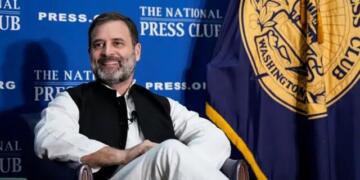All the diplomatic capital that Prime Minister Modi has been accumulating since 2014 seems to be helping New Delhi when needed the most. The world is changing and the Indo-Pacific Region is driving this change with the emergence of China as a real threat.
India, however, is benefiting from the fact that PM Modi’s ‘Act East Policy’, which can also be seen as a part of the larger Indo-Pacific strategy, has set regional equations perfectly for New Delhi.
Powered by closer ties with India, ASEAN countries have started denouncing China’s revisionist claims in the region openly. Even countries like the Philippines that were once seen as getting closer to Beijing have started condemning Chinese actions.
The Association of South-East Asian Nations (ASEAN) is at the centre of Prime Minister Modi’s ‘Act East Policy’. Over 2014, New Delhi has therefore bolstered its ties with key players in the region such as Vietnam, the Philippines and Indonesia.
It is not a mere coincidence that when ridiculed by the entire world for the Coronavirus cover-up, China started flexing its muscles in the South China Sea and also provoked military tensions with India at the Line of Actual Control (LAC) in Eastern Ladakh.
China is an expansionist country that has border and maritime disputes in the entire region. Chinese belligerence had to happen sooner or later and this formed the bedrock of PM Modi’s ‘Act East Policy’.
Southeast Asian country and India have a common link that binds them. Both of them want to counter China’s ‘Salami Slicing’ tactics- a strategy that denotes growing Chinese expansionism in the Himalayas and the South China Sea.
In the case of India, China wants to keep pushing the Line of Actual Control (LAC)- the de facto Sino-India border further West. And in the South China Sea, Beijing has been claiming historical maritime rights under its nine-dash claim line theory.
Beijing has encircled as much as 90 per cent of the strategic waterways running as far as 2,000 kilometres away from China. Chinese vessels routinely intrude into the territorial waters and Exclusive Economic Zones (EEZs) of countries like Malaysia, the Philippines and Vietnam.
China doesn’t care for international rules. Its claims against India violate international law and its actions in the South China Sea are in utter defiance of the UN Convention for the Law of the Sea. China doesn’t even abide by the 2016 Award pronounced by the Permanent Court of Arbitration located in the Hague. The Award makes it clear that China’s claims in the maritime region are illegal.
India’s interaction with countries like Vietnam, the Philippines and Indonesia has invariably revolved around ensuring free navigation in the strategic waterways and elevating strategic ties in view of the convergence of security interests.
PM Modi has made it a point to increase interaction with the ASEAN. In 2015 itself, India established a separate Mission to ASEAN and the East Asia Summit (EAS) in Jakarta with a dedicated Ambassador. The purpose of this move was to “strengthen engagement with ASEAN and ASEAN-centric process”.
In 2018, India hosted the ten leaders from the regional bloc for its Republic Day celebrations. New Delhi quite literally embraced the Southeast Asian countries when they were being bullied by China.
ASEAN doesn’t have a problem with India’s rise. They see China’s rise as a threat to their own security, but New Delhi’s rise to power only creates an effective security net for them.
Now, these countries are showing that they are keen at the prospect of India entering the South China Sea and countering Chinese hegemony.
The Philippines Defence Minister Delfin Lorenzana has announced that India is interested in navigation in the South China Sea region.
Lorenzana has also made it clear that the Philippines is open to India entering the South China Sea region. Defence ties are clearly getting bolstered here. Earlier, the Philippines Navy chief Rear Admiral Giovanni Carlo J. Bacordo had thanked the Indian Navy for its “invaluable alliance”. Manila is giving feelers to New Delhi for greater partnership in the strategic waterways of the South China Sea.
Vietnam too is warming up to India with both Indian and Vietnamese experts calling for strengthening public diplomacy between the two countries.
Indonesia, which is also facing a Chinese challenge in its EEZ, could also consider a bilateral strategy with India to counter Beijing. The Strait of Malacca passes through Indonesia connecting the Indian and Pacific Oceans. At the end of the day, Indonesia is India’s key to seamlessly access strategic waterways.
All countries facing trouble with Chinese expansionism in the South China Sea are today relying on India’s goodwill. For the past six years, they have benefitted from India’s ‘Act East Policy’. Now, they realise that India could swing the balance of power in their favour if the Indian Navy enters the South China Sea.
The ASEAN also realises how India has increased interaction with Japan, Australia and the US in order to tighten its grip on the Western Pacific Region. The South China Sea sits right at the centre of the Western Pacific.
Traditionally, the US has ensured that a balance of power is maintained and Beijing doesn’t become too powerful in the South China Sea. Australia too carries out free navigation exercises in order to keep the Dragon in check.
But it is India’s entry in the South China Sea that will work out as a force multiplier for Vietnam, Indonesia, the Philippines, Brunei and even Malaysia.
Even apart from the South China Sea, India has been improving its ties with Myanmar. Myanmar is crucial to PM Modi’s ‘Act East Policy’. It is India’s gateway into Southeast Asia. The Kala Adan Multi-modal Transit Transport Project based in Myanmar will also help India in reaching and protecting its own North-east more effectively.
The interests of the two countries have got aligned against China, as both of them are battling insurgency outfits that are supported by China’s Yunnan-based ordnance company, NORINCO. The Armies of India and Myanmar are cooperating in the defence sector and carrying out joint operations against insurgent outfits.
As a result, Myanmar has been giving a cold shoulder to Beijing on issues like BRI projects.
This is why we suddenly see the ASEAN feeling emboldened to take on China. India’s ‘Act East Policy’ is a massive confidence-building measure and it is bearing fruit in the face of a belligerent China.






























